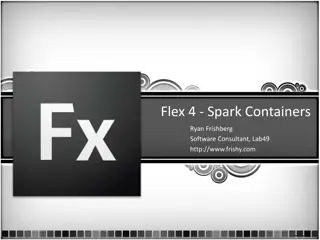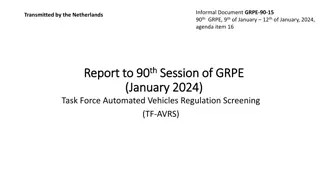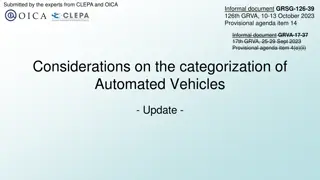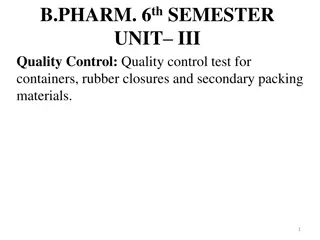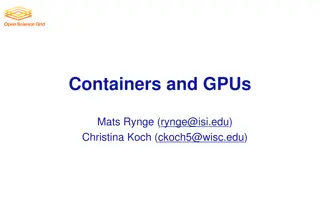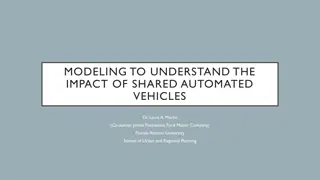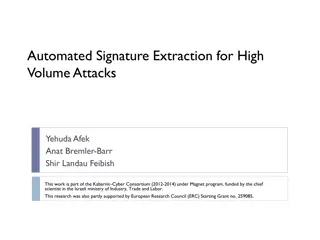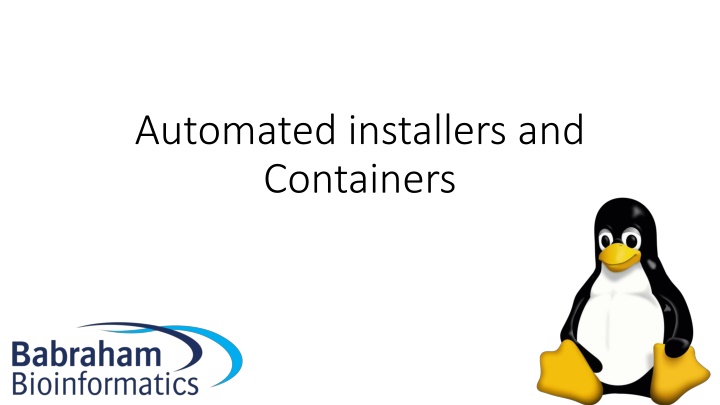
Automated Installers and Containers: Simplifying Software Management
"Discover how automated installers like Conda streamline software installation and management, providing a versatile solution for various types of software. Learn about setting up environments, adding channels, installing packages, and common challenges with Conda usage."
Download Presentation

Please find below an Image/Link to download the presentation.
The content on the website is provided AS IS for your information and personal use only. It may not be sold, licensed, or shared on other websites without obtaining consent from the author. If you encounter any issues during the download, it is possible that the publisher has removed the file from their server.
You are allowed to download the files provided on this website for personal or commercial use, subject to the condition that they are used lawfully. All files are the property of their respective owners.
The content on the website is provided AS IS for your information and personal use only. It may not be sold, licensed, or shared on other websites without obtaining consent from the author.
E N D
Presentation Transcript
Automated installers and Containers
Automated Installers Like a package manager, but independent of Operating System Some will operate from source, distributing recipes Some will distribute pre-compiled binaries Most common examples Conda (https://conda.io) Easy Build (https://easybuild.readthedocs.io)
Conda Package management system Originally for python packages, but now covers all types of software Several Implementations Anaconda (original distribution, with a full python environment) Miniconda (small distribution, just for running conda) Add-in repositories for more packages BioConda (https://bioconda.github.io/)
Using conda Install a conda providing environment (probably miniconda) Set up some channels (bioconda) Install some packages Use the packages
Installing miniconda Go to https://conda.io/miniconda.html Download the shell script for your platform Run it Will install into your home directory - each user gets a separate install Will offer to modify your PATH to include the miniconda bin directory* *Be careful about this!!
Adding bioconda channels conda config --add channels bioconda conda config --add channels conda-forge Bioconda will now be searched for new installs
Installing packages with conda Simple installs [but don't do this] conda install bwa conda install bwa=0.7.4 Custom environments conda create -n aligners source activate aligners conda install bwa bowtie2 hisat2 source deactivate
Problems with conda? Only software available in the repositories Pretty comprehensive these days Closed environment Can't mix and match with things from the base OS (well you can, but stuff will break!) Duplication Every user (and every environment) gets their own copy of everything Duplication (again) Will install its own R / perl / python etc and will put it first in the path Can break non-conda applications in odd ways Always use a named environment
Containers A method for bundling software and data together into a single item which can be ported easily between users/computers Can provide an isolated environment - similar to a VM or a conda environment, or make a suite of programs/data look like an application Main systems Docker* Singularity* (https://www.docker.com/) (https://www.sylabs.io/singularity/) *They play nicely together
Finding a container DockerHub (https://hub.docker.com) SingularityHub (https://singularity-hub.org) Search for the application / user / container you want Find the address (user/name) eg vsoch/hello-world
Installing singularity Available from apt in Debian/Ubuntu sudo apt install singularity-container Note that just "singularity" is a game! Compile from source (https://github.com/sylabs/singularity/releases) v2.6.0 is autotools based - similar install to previous apps v3.0.0 is re-written in GOLang so has a custom install procedure
Installing a container Download from a repository and install onto your machine singularity pull shub://dleehr/qiime2-singularity singularity pull docker://qiime2/core File names can get a bit long, so: singularity pull --name qiime.simg docker://qiime2/core Produces a .simg file on your machine
Using a container Different options. You can start a shell in the environment of the container singularity shell qiime.simg You can run a script which the image provides singularity run qiime.simg ./qiime.simg





